Nitrogen Supply Affects Grain Yield by Regulating Antioxidant Enzyme Activity and Photosynthetic Capacity of Maize Plant in the Loess Plateau
Abstract
:1. Introduction
2. Materials and Methods
2.1. Site Description
2.2. Experiment Design
2.3. Measurements and Calculations
2.3.1. Morphological Characteristics and Dry Weight
2.3.2. Photosynthetic Indices
2.3.3. Leaf Chlorophyll
2.3.4. Antioxidant Enzyme Activities
2.3.5. POD and SOD Isozyme Electrophoresis
2.3.6. Grain Yield
2.4. Statistical Analysis
3. Results
3.1. Maize Morphological Characteristics as Affected by N Supply
3.2. Leaf Chlorophyll as Affected by N Supply
3.3. Leaf Photosynthetic Characteristics as Affected by N Supply
3.4. Antioxidant Enzyme Activities as Affected by N Supply
3.5. POD and SOD Isozyme Activities as Affected by N Supply
3.6. Grain Yield as Affected by N Supply
3.7. Correlation Analysis of Antioxidant Enzyme Activities, Photosynthetic and Morphological Characteristics, and Yield
4. Discussion
5. Conclusions
Author Contributions
Funding
Acknowledgments
Conflicts of Interest
References
- Ciampitti, I.A.; Vyn, T.J. Physiological Perspectives of Changes over Time in Maize Yield Dependency on Nitrogen Uptake and Associated Nitrogen Efficiencies: A Review. Field Crops Res. 2012, 133, 48–67. [Google Scholar] [CrossRef]
- Tilman, D.; Balzer, C.; Hill, J.; Befort, B.L. Global Food Demand and the Sustainable Intensification of Agriculture. Proc. Natl. Acad. Sci. USA 2011, 108, 20260–20264. [Google Scholar] [CrossRef] [Green Version]
- Zheng, J.; Fan, J.L.; Zhang, F.C.; Yan, S.C.; Xiang, Y.Z. Rainfall Partitioning into Throughfall, Stemflow and Interception Loss by Maize Canopy on the Semi-Arid Loess Plateau of China. Agric. Water Manag. 2018, 195, 25–36. [Google Scholar] [CrossRef]
- Zhang, X.D.; Cai, H.J.; Fu, Y.J.; Wang, J. Study on Leaf Area Index of Summer Maize in Loess Areas. Agric. Res. Arid Areas. 2005, 24, 25–29. [Google Scholar]
- Ju, X.T.; Xing, G.X.; Chen, X.P.; Zhang, S.L.; Zhang, L.J.; Liu, X.J.; Cui, Z.L.; Yin, B.; Christie, P.; Zhu, Z.L.; et al. Reducing Environmental Risk by Improving N Management in Intensive Chinese Agricultural Systems. Proc. Natl. Acad. Sci. USA 2009, 106, 3041–3046. [Google Scholar] [CrossRef] [Green Version]
- Morell, F.J.; Lampurlanés, J.; Álvaro-Fuentes, J.; Cantero-Martínez, C. Yield and Water Use Efficiency of Barley in a Semiarid Mediterranean Agroecosystem: Long-Term Effects of Tillage and N Fertilization. Soil Till. Res. 2011, 117, 76–84. [Google Scholar] [CrossRef] [Green Version]
- Sharifi, R.S.; Namvar, A. Effects of Time and Rate of Nitrogen Application on Phenology and Some Agronomical Traits of Maize (Zea Mays L.). Biologija 2016, 62, 35–45. [Google Scholar] [CrossRef]
- Fernandez, J.A.; DeBruin, J.; Messina, C.D.; Ciampitti, I.A. Late-Season Nitrogen Fertilization on Maize Yield: A Meta-Analysis. Field Crops Res. 2020, 247, 107586. [Google Scholar] [CrossRef]
- Li, H.; Kuang, N.; Gou, Q.; Ma, Y.; Li, Q. Effects of Different Film Mulches on Photosynthetic Characteristics and Yield of Summer Maize (Zea Mays L.) in the North China Plain. Arch. Agron. Soil Sci. 2021, 67, 179–190. [Google Scholar] [CrossRef]
- Hallof, N.; Sárvári, M. Effect of Different Fertilizer Doses on Yield, LAI and Photosynthetic Activity of Maize Hybrids. Cereal Res. Commun. 2006, 34, 441–444. [Google Scholar] [CrossRef]
- Denis, B.; Marcelo, M.; Lucia, M. Nitrogen Supply Influences Photosynthesis Establishment along the Sugarcane Leaf. Sci. Rep. 2018, 8, 2327. [Google Scholar]
- Uribelarrea, M.; Crafts-Brandner, S.J.; Below, F.E. Physiological N Response of Field-Grown Maize Hybrids (Zea Mays L.) with Divergent Yield Potential and Grain Protein Concentration. Plant. Soil 2009, 316, 151. [Google Scholar] [CrossRef] [Green Version]
- Li, D.; Tian, M.; Cai, J.; Jiang, D.; Cao, W.; Dai, T. Effects of Low Nitrogen Supply on Relationships Between Photosynthesis and Nitrogen Status at Different Leaf Position in Wheat Seedlings. Plant. Growth Regul. 2013, 70, 257–263. [Google Scholar] [CrossRef]
- Zhang, Z.; Zhang, Y.; Shi, Y.; Yu, Z. Optimized Split Nitrogen Fertilizer Increase Photosynthesis, Grain Yield, Nitrogen Use Efficiency and Water Use Efficiency under Water-Saving Irrigation. Sci. Rep. 2020, 10, 1–14. [Google Scholar] [CrossRef]
- Stevens, W.B.; Hoeft, R.G.; Mulvaney, R.L. Fate of 15N in a Long-Term Nitrogen Rate Study: I. Interactions with Soil Nitrogen. Agron. J. 2005, 97, 1037–1045. [Google Scholar] [CrossRef]
- Okamura, M.; Arai-Sanoh, Y.; Yoshida, H.; Mukouyama, T.; Adachi, S.; Yabe, S.; Nakagawa, H.; Tsutsumi, K.; Taniguchi, Y.; Kobayashi, N.; et al. Characterization of High-Yielding Rice Cultivars with Different Grain-Filling Properties to Clarity Limiting Factors for Improving Grain Yield. Field Crops Res. 2018, 219, 139–147. [Google Scholar] [CrossRef]
- Kochhar, S.; Kochhar, V.K. Expression of Antioxidant Enzymes and Heat Shock Proteins in Relation to Combined Stress of Cadmium and Heat in Vigna Mungo Seedlings. Plant. Sci. 2005, 168, 921–929. [Google Scholar] [CrossRef]
- Ahmadi, A.; Emam, Y.; Pessarakli, M. Biochemical Changes in Maize Seedlings Exposed to Drought Stress Conditions at Different Nitrogen Levels. J. Plant. Nutr. 2010, 33, 541–556. [Google Scholar] [CrossRef]
- Wu, J.; Fu, T.; Zheng, C.; Yang, G.; Shen, F. Effects of Nitrogen Fertilizer on Biomass, Chlorophyll Content and Antioxidant Enzyme Activities of Picris Japonica Thunb under Pb Stress. Acta Agric. Boreali Sin. 2015, 30, 213–218. [Google Scholar]
- Zhang, Z.; Yu, Z.; Zhang, Y.; Shi, Y. Split Nitrogen Fertilizer Application Improved Grain Yield in Winter Wheat (Triticum Aestivum L.) Via Modulating Antioxidant Capacity and 13 C Photosynthate Mobilization under Water-Saving Irrigation Conditions. Ecol. Process. 2021, 10, 1–13. [Google Scholar] [CrossRef]
- Zhao, Q.; Zhou, L.; Liu, J.; Du, X.; Huang, F.; Pan, G.; Cheng, F. Relationship of ROS Accumulation and Superoxide Dismutase Isozymes in Developing Anther with Floret Fertility of Rice under Heat Stress. Plant Physiol. Biochem. 2018, 122, 90–101. [Google Scholar] [CrossRef]
- Shah, K.; Nahakpam, S. Heat Exposure Alters the Expression of SOD, POD, APX and CAT Isozymes and Mitigates Low Cadmium Toxicity in Seedlings of Sensitive and Tolerant Rice Cultivars. Plant. Physiol. Biochem. 2012, 57, 106–113. [Google Scholar] [CrossRef]
- Walsh, O.; Raun, W.; Klatt, A.; Solie, J. Effect of Delayed Nitrogen Fertilization on Maize (Zea Mays L.) Grain Yields and Nitrogen Use Efficiency. J. Plant. Nutr. 2012, 35, 538–555. [Google Scholar] [CrossRef] [Green Version]
- FAO. Soil Map of the World: Revised Legend. In World Soil Resources Report; FAO: Rome, Italy, 1990; Volume 60. [Google Scholar]
- Xie, J.; Chai, Q.; Li, L.; Zhang, R.; Niu, Y.; Luo, Z. The Time Loading Limitation of Continuous Cropping Maize Yield under Different Plastic Film Mulching Modes in Semi-Arid Region of Loess Plateau of China. Sci. Agric. Sin. 2015, 48, 1558–1568. [Google Scholar]
- Wei, S.; Wang, X.; Shi, D.; Li, Y.; Zhang, J.; Liu, P.; Zhao, B.; Dong, S. The Mechanisms of Low Nitrogen Induced Weakened Photosynthesis in Summer Maize (Zea Mays L.) under Field Conditions. Plant. Physiol. Biochem. 2016, 105, 118–128. [Google Scholar] [CrossRef]
- Wang, P.; Zhang, X.L.; Shi, L. Changes of Photosynthetic Characteristics and Chlorophyll Fluorescence Parameters of Pugionium Cornutum (L.) Gaertn Seedlings Leaf under Drought Stress. Agric. Res. Arid Areas 2017, 35, 159–163. [Google Scholar]
- Li, H. Principles and Techniques of Plant Physiological Biochemical Experiment; Higher Education Press: Beijing, China, 2000. [Google Scholar]
- He, Z.X.; Zhang, S.Z. Electrophoresis. The Second Press; Science Press: Beijing, China, 1999. [Google Scholar]
- Liu, H.; Huang, X.; Huang, M.; Chi, B.; Zheng, X.; Chen, J. Effects of Drought Stress at Jointing Stage on Yield and Drought Resistance in Spring Maize. Crops 2016, 2, 89–94. [Google Scholar]
- Cai, H.G.; Yuan, J.C.; Liu, J.Z.; Yan, G.X.; Zhang, H.X.; Liang, Y. Optimal Nitrogen Application Rate and Nitrogen Requirement Characteristics in Spring Maize under High Planting Density Condition. Sci. Agric. Sin. 2017, 50, 1995–2005. [Google Scholar]
- Jin, X.; Li, W.; Hu, D.; Shi, X.; Zhang, X.; Zhang, F.; Fu, Z.; Ding, D.; Liu, Z.; Tang, J. Biological Responses and Proteomic Changes in Maize Seedlings under Nitrogen Deficiency. Plant. Mol. Biol. Rep. 2015, 33, 490–504. [Google Scholar] [CrossRef]
- Wasaya, A.; Tahir, M.; Ali, H.; Hussain, M.; Yasir, T.A.; Sher, A.; Ijaz, M. Influence of Varying Tillage Systems and Nitrogen Application on Crop Allometry, Chlorophyll Contents, Biomass Production and Net Returns of Maize (Zea mays L.). Soil Tillage Res. 2017, 170, 18–26. [Google Scholar] [CrossRef]
- Millard, P. The Accumulation and Storage of Nitrogen by Herbaceous Plants. Plant. Cell Environ. 1998, 11, 1–8. [Google Scholar] [CrossRef]
- Zhou, B.; Sun, X.; Ding, Z.; Ma, W.; Zhao, M. Multisplit Nitrogen Application Via Drip Irrigation Improves Maize Grain Yield and Nitrogen Use Efficiency. Crop. Sci. 2017, 57, 1687–1703. [Google Scholar] [CrossRef] [Green Version]
- Cheng, Z.; Ya, F.U.; Zong, S. Relationship between Leaf Senescence and Activated Oxygen Metabolism in Super High Yielding Rice During Flowering and Grain Formation Stage. Chin. J. Rice Sci. 2002, 16, 326–330. [Google Scholar]
- Mu, X.; Chen, Q.; Chen, F.; Yuan, L.; Mi, G. A RNA-seq Analysis of the Response of Photosynthetic System to Low Nitrogen Supply in Maize Leaf. Int. J. Mol. Sci. 2017, 18, 2624. [Google Scholar] [CrossRef] [Green Version]
- Vos, J.; Van Der Putten, P.E.L.; Birch, C.J. Effect of Nitrogen Supply on Leaf Appearance, Leaf Growth, Leaf Nitrogen Economy and Photosynthetic Capacity in Maize (Zea mays L.). Field Crops Res. 2005, 93, 64–73. [Google Scholar] [CrossRef]
- Liu, J.Z.; Yuan, J.C.; Zhou, K.; Liang, Y.; Yan, X.G.; Zhang, H.X.; Ren, J.; Cai, H.J. Effect of Different Nitrogen Fertilizer Application Rates on Photosynthetic Characteristic and Yield. J. Maize Sci. 2019, 27, 151–157. [Google Scholar]
- Farquhar, G.D.; Sharkey, T.D. Stomatal Conductance and Photosynthesis. Ann. Rev. Plant. Physiol. 1982, 33, 317–345. [Google Scholar] [CrossRef]
- Ma, X.; Zheng, J.; Zhang, X.; Hu, Q.; Qian, R. Salicylic Acid Alleviates the Adverse Effects of Salt Stress on Dianthus superbus by Activating Photosynthesis, Protecting Morphological Structure, and Enhancing the Antioxidant System. Front. Plant. Sci. 2017, 8, 600. [Google Scholar] [CrossRef]
- Li, C. Effects of Enhanced Ammonium Nutrition on Growth and Development of Maize. J. Northeast. Agric. Univ. 2002, 33, 313–318. [Google Scholar]
- Wang, J.Z.; Zhang, C.N.; Zhao, H.J. Effects of Different Fertilization Methods on Chlorophyll Fluorescence Parameters and Yield of Summer Maize. Plant. Nutr. Fert. Sci. 2008, 14, 479–483. [Google Scholar]
- Zakari, S.A.; Asad, M.A.U.; Han, Z.; Zhao, Q.; Cheng, F. Relationship of Nitrogen Deficiency-Induced Leaf Senescence with ROS Generation and ABA Concentration in Rice Flag Leaves. J. Plant. Growth Regul. 2020, 1–15. [Google Scholar] [CrossRef]
- Shin, R.; Berg, R.H.; Schachtman, D.P. Reactive Oxygen Species and Root Hairs in Arabidopsis Root Response to Nitrogen, Phosphorus and Potassium Deficiency. Plant. Cell Physiol. 2005, 46, 1350–1357. [Google Scholar] [CrossRef]
- Wang, H.Z.; Zhang, J.; Wu, J.Z.; Xu, G.W.; Chen, M.C.; Fu, G.Z.; Li, Y.J. Effect of Different Levels of Nitrogen on Physiological Characteristics of Flag Leaves and Grain Yield of Wheat. Acta Prataculturae Sin. 2013, 22, 69–75. [Google Scholar]
- Solórzano, E.; Corpas, F.J.; González-Gordo, S.; Palma, J.M. Reactive Oxygen Species (Ros) Metabolism and Nitric Oxide (No) Content in Roots and Shoots of Rice (Oryza Sativa L.) Plants under Arsenic-Induced Stress. Agronomy 2020, 10, 1014. [Google Scholar] [CrossRef]
- Song, Y.; Li, J.; Liu, M.; Meng, Z.; Liu, K.; Sui, N. Nitrogen Increases Drought Tolerance in Maize Seedlings. Funct. Plant. Biol. 2019, 46, 350–359. [Google Scholar] [CrossRef]
- Chen, Y.; Xiao, C.; Wu, D.; Xia, T.; Chen, Q.; Chen, F.; Yuan, L.; Mi, G. Effects of Nitrogen Application Rate on Grain Yield and Grain Nitrogen Concentration in Two Maize Hybrids with Contrasting Nitrogen Remobilization Efficiency. Eur. J. Agron. 2015, 62, 79–89. [Google Scholar] [CrossRef]
- Joshi, A.; Gupta, J.K.; Choudhary, S.K.; Paliwal, D.K. Efficiency of Different Nitrogen Source, Doses and Split Application on Growth and Yield of Maize (Zea Mays L.) in the Malwa Region of Madhya Pradesh. IOSR J. Agric. Veter. Sci. 2014, 7, 2319–2372. [Google Scholar] [CrossRef]
- Zhang, L.; Liu, H.H.; Sun, J.Q.; Li, J.C.; Song, Y.H. Seeding Characteristics and Grain Yield of Maize Grown Under Straw Retention Affected by Sowing Irrigation and Splitting Nitrogen Use. Field Crops Res. 2018, 225, 22–31. [Google Scholar] [CrossRef]
- Lamptey, S.; Li, L.; Xie, J.; Zhang, R.; Yeboah, S.; Antille, D.L. Photosynthetic Response of Maize to Nitrogen Fertilization in the Semiarid Western Loess Plateau of China. Crop. Sci. 2017, 57, 2739–2752. [Google Scholar] [CrossRef]
- Acciaresi, H.A.; Tambussi, E.A.; Antonietta, M.; Zuluaga, M.S.; Andrade, F.H.; Guiamét, J.J. Carbon Assimilation, Leaf Area Dynamics, and Grain Yield in Contemporary Earlier—and Later-Senescing Maize Hybrids. Eur. J. Agron. 2014, 59, 29–38. [Google Scholar] [CrossRef]

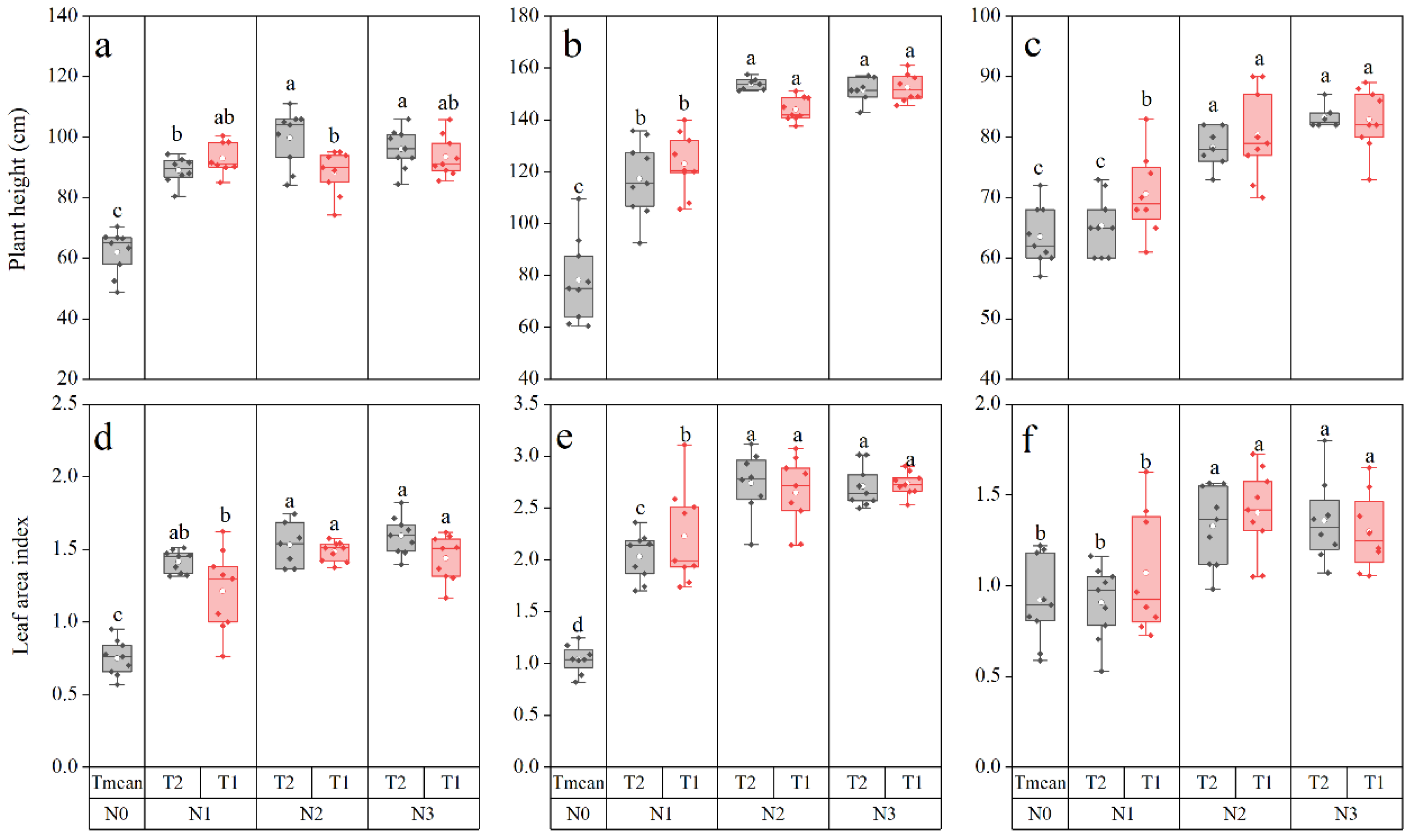
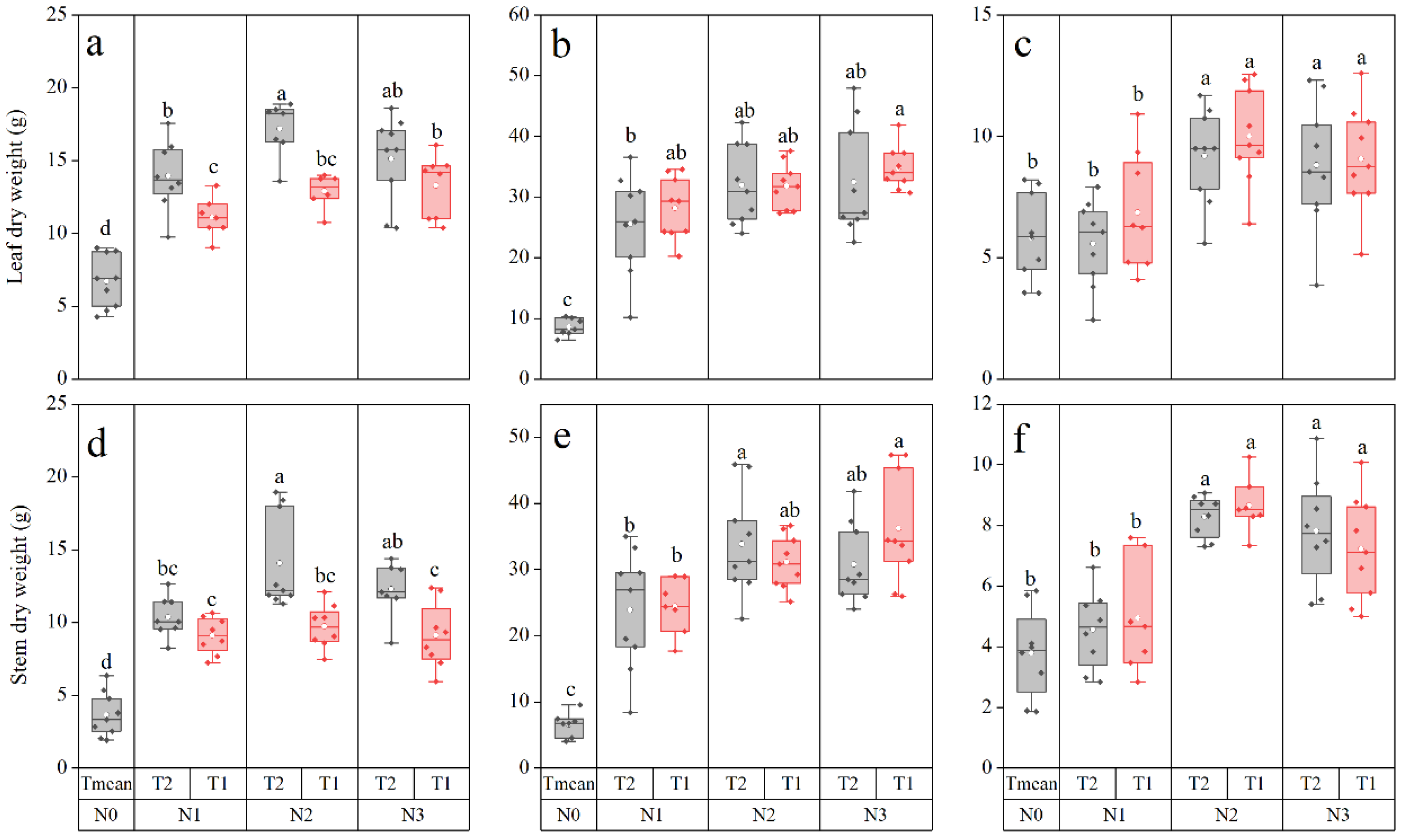

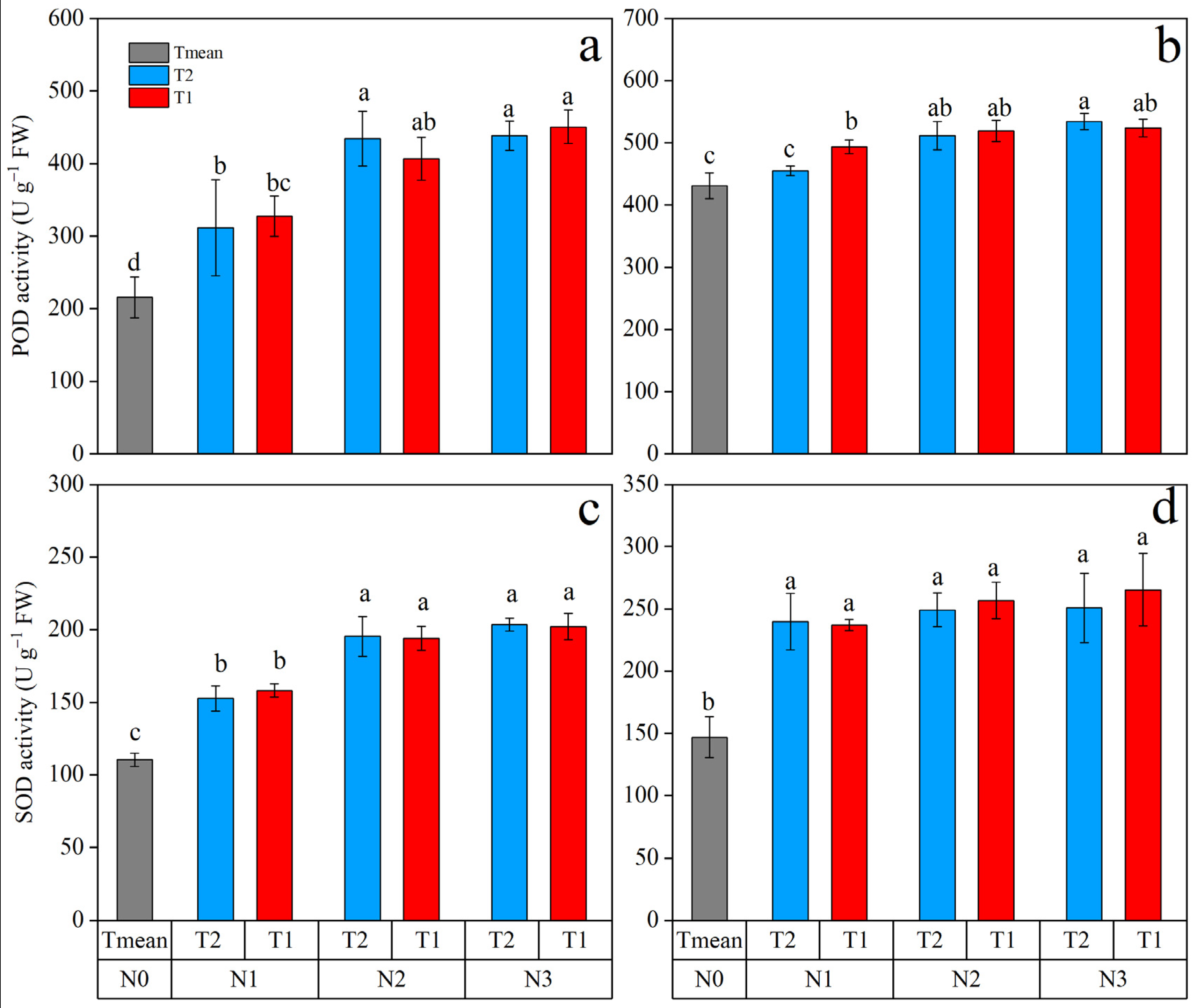
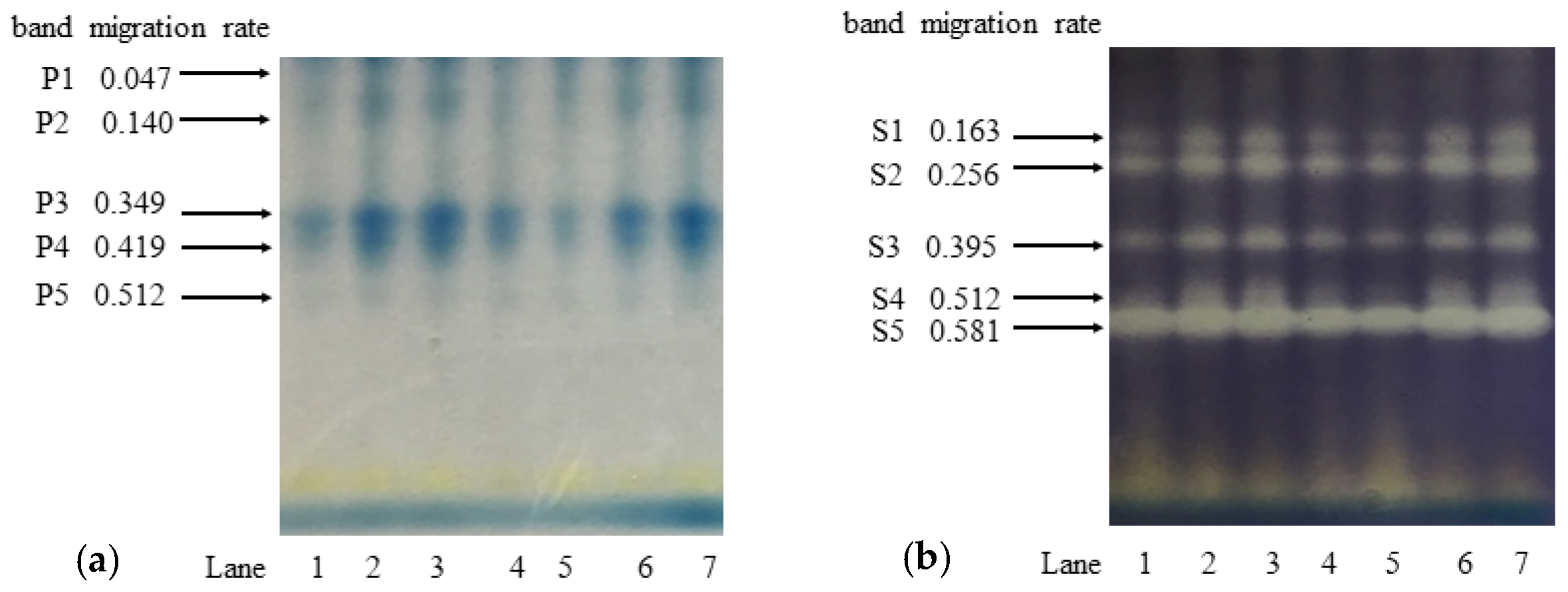

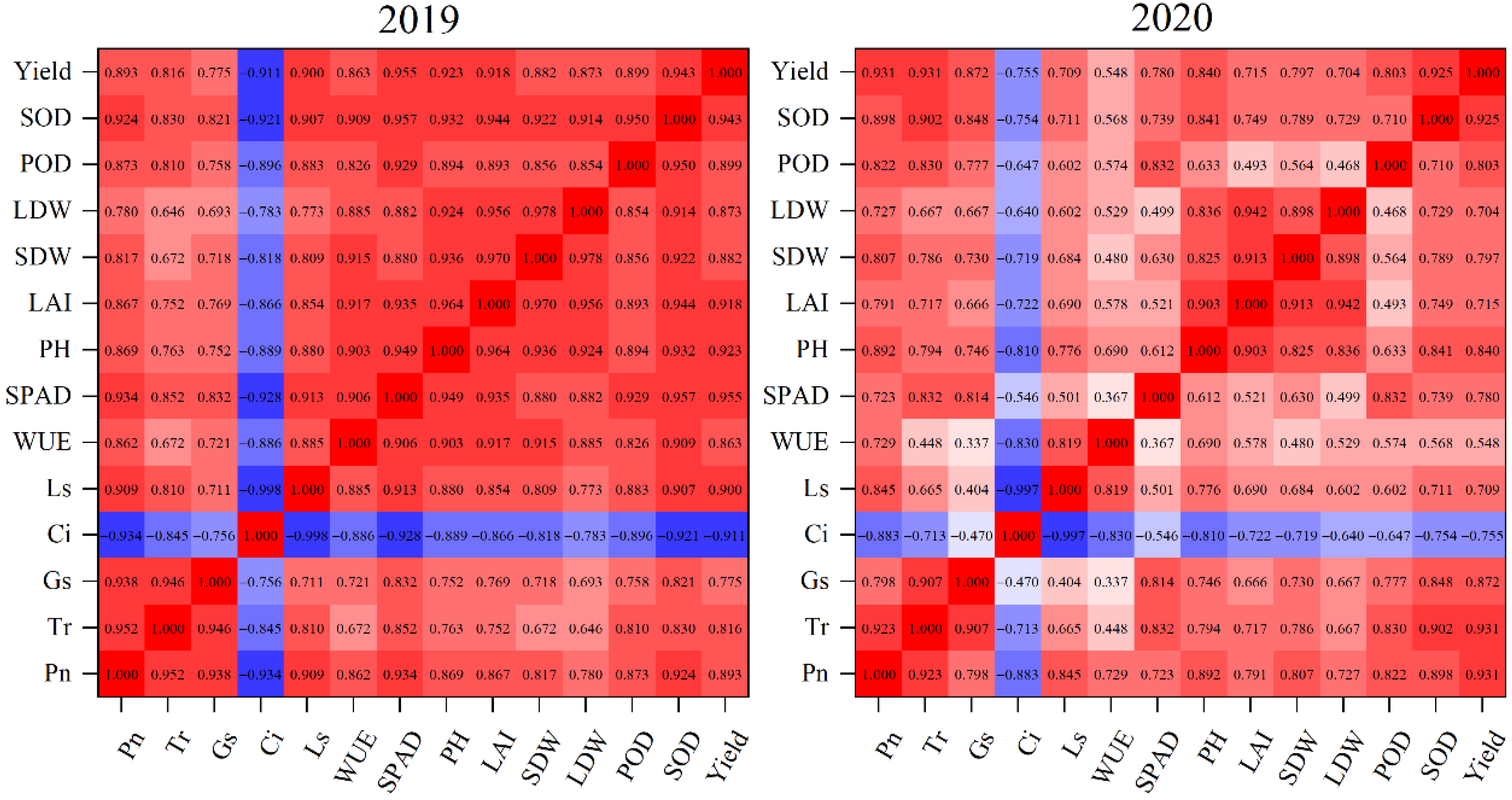
| Year | N Rate | N Timing | Pn (μmol·m−2·s−1) | Gs (μmol·m−2·s−1) | Ci (ppm) | Tr (mmol·m−2·s−1) | Ls (%) | WUE (μmol·CO2· mmol−1·H2O) |
|---|---|---|---|---|---|---|---|---|
| N0 | 18.53 b | 215.24 b | 206.24 a | 7.07 b | 0.42 c | 2.62 d | ||
| N1 | T2 | 24.59 b | 246.26 b | 185.35 ab | 6.81 b | 0.47 bc | 3.61 bc | |
| N1 | T1 | 26.04 ab | 232.25 b | 161.52 b | 7.36 b | 0.54 b | 3.54 c | |
| N2 | T2 | 42.70 a | 312.80 a | 103.06 a | 10.75 a | 0.69 a | 3.97 abc | |
| 2019 | N2 | T1 | 46.84 a | 360.26 a | 105.16 a | 11.89 a | 0.67 a | 3.95 abc |
| N3 | T2 | 43.65 a | 323.19 a | 97.12 a | 10.80 a | 0.70 a | 4.06 ab | |
| N3 | T1 | 47.53 a | 374.23 a | 109.40 a | 11.48 a | 0.66 a | 4.14 a | |
| F-value | N | 79.08 ** | 21.87 ** | 63.31 ** | 51.07 ** | 46.11 ** | 35.24 ** | |
| T | 2.35 ns | 2.14 ns | 0.13 ns | 3.11 ns | 0.01 ns | 0.00 ns | ||
| N × T | 0.42 ns | 1.31 ns | 1.39 ns | 0.48 ns | 1.38 ns | 0.09 ns | ||
| N0 | 9.02 d | 126.93 c | 226.74 a | 3.19 d | 0.36 b | 2.98 ab | ||
| N1 | T2 | 23.43 c | 227.14 b | 191.03 ab | 7.28 c | 0.44 ab | 3.21 ab | |
| N1 | T1 | 24.91 c | 310.08 a | 203.18 ab | 8.74 b | 0.40 ab | 2.85 b | |
| N2 | T2 | 34.76 ab | 332.62 a | 145.76 bc | 9.49 ab | 0.55 ab | 3.67 ab | |
| 2020 | N2 | T1 | 38.56 ab | 318.63 a | 122.03 c | 9.92 a | 0.62 ab | 3.87 ab |
| N3 | T2 | 43.02 a | 334.32 a | 104.81 c | 10.46 a | 0.67 a | 4.12 a | |
| N3 | T1 | 38.94 ab | 327.31 a | 122.65 c | 9.80 ab | 0.62 ab | 3.97 ab | |
| F-value | N | 82.90 ** | 43.18 ** | 13.36 ** | 146.26 ** | 3.90 * | 3.54 * | |
| T | 0.04 ns | 1.15 ns | 0.01 ns | 1.34 ns | 0.62 ns | 0.08 ns | ||
| N × T | 1.11 ns | 2.46 ns | 0.41 ns | 2.84 ns | 0.91 ns | 0.17 ns |
Publisher’s Note: MDPI stays neutral with regard to jurisdictional claims in published maps and institutional affiliations. |
© 2021 by the authors. Licensee MDPI, Basel, Switzerland. This article is an open access article distributed under the terms and conditions of the Creative Commons Attribution (CC BY) license (https://creativecommons.org/licenses/by/4.0/).
Share and Cite
Yue, K.; Li, L.; Xie, J.; Fudjoe, S.K.; Zhang, R.; Luo, Z.; Anwar, S. Nitrogen Supply Affects Grain Yield by Regulating Antioxidant Enzyme Activity and Photosynthetic Capacity of Maize Plant in the Loess Plateau. Agronomy 2021, 11, 1094. https://doi.org/10.3390/agronomy11061094
Yue K, Li L, Xie J, Fudjoe SK, Zhang R, Luo Z, Anwar S. Nitrogen Supply Affects Grain Yield by Regulating Antioxidant Enzyme Activity and Photosynthetic Capacity of Maize Plant in the Loess Plateau. Agronomy. 2021; 11(6):1094. https://doi.org/10.3390/agronomy11061094
Chicago/Turabian StyleYue, Kai, Lingling Li, Junhong Xie, Setor Kwami Fudjoe, Renzhi Zhang, Zhuzhu Luo, and Sumera Anwar. 2021. "Nitrogen Supply Affects Grain Yield by Regulating Antioxidant Enzyme Activity and Photosynthetic Capacity of Maize Plant in the Loess Plateau" Agronomy 11, no. 6: 1094. https://doi.org/10.3390/agronomy11061094






